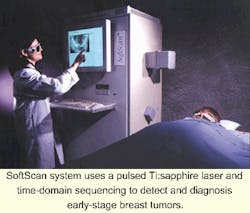Advanced Research and Technology (ART; Montreal, Canada), a publicly traded Canadian company that develops optical-imaging technologies for medical and industrial applications, has emerged as another contender in the laser mammography field. ART is nearing completion of Phase II clinical trials of its SoftScan Ti:sapphire laser-based system and expects to move into multisite Phase III trials before year's end.
The current clinical trial, at a single site in Quebec City, was intended to assess the system's ability to detect and analyze early signs of benign or malignant lesions in dense tissue or in breasts that have undergone surgery, received implants, or been treated with hormones. Some 50 patients have so far participated in the trial and early findings have been promising, according to the company.
The SoftScan system can be used without breast compression and is designed for the early detection of cancer, especially in young women whose body tissue is very dense and thus difficult to x-ray clearly. Current prototypes rely on a Ti:sapphire laser that can be tuned to four key wavelengths between 740 and 860 nm, according to Pierre Beaudry, who is responsible for R&D and engineering at ART (see figure). Commercial versions of the system will likely utilize diode lasers, however.
The laser works in conjunction with a high-temporal-resolution detector and proprietary software to capture and analyze specific photon-based data, determine the presence of tumor masses, and assess whether the involved tissue is malignant. A time-domain approach is used to track the emerging photons and provide as much detailed information as possible about the tissue they have come through.
"Capturing the data is kind of easy," Beaudry says. "The bigger issue is what you do with it and how you use it. The key is capturing the photons as they come out and determining where they came from. We know how many photons hit and how intense the strike was."
The SoftScan system links each wavelength with several data sets that represent various indications of cancer. ART is initially focusing on some commonly accepted indications, such as blood-volume levels (oxyhemoglobin) and oxygen saturation levels.
"Various research groups around the world have reported that, when it comes to malignant tumors, you see unusual levels of oxygen saturation," Beaudry says. "Our story is abnormal oxygen saturation levels, which are linked to the abnormal growth rate of tumor tissue."
Evaluating the competition
ART is not the only company actively developing a commercial laser mammography system. Imaging Diagnostic Systems (IDS; Plantation, FL) has been developing a computed-tomography laser mammography (CTLM) system for the last few years, and clinical trials are ongoing. The SoftScan is similar to IDS's CTLM system in that the laser energy (the CTLM system uses a diode laser) is trained on one side of the breast and a detector on the other side detects light as it is transmitted through tissue. However, Softscan uses a stationary light source to create 2-D images, whereas CTLM's lasers rotate around the breast to create 3-D tomographic images.
According to Beaudry, the SoftScan system offers some significant advantages over the IDS system, however. Foremost among these is the fact that the Softscan uses a pulsed rather than a CW laser, which means it can acquire more comprehensive data about the tissue it is imaging.
"We are firm believers that a time-domain system can outperform a frequency domain or CW system," Beaudry says. "You are very limited in the amount of information you can get with a CW system because all you are basically measuring is photon transmission." IDS is also actively involved in clinical trials, and expects to submit its premarket approval application to the US Food and Drug Administraion (FDA) this year.
ART expects to receive regulatory clearance in Canada, the USA, and Europe in late 2001, with commercial release in early 2002. Once those hurdles are cleared, the company plans to commercialize and market the SoftScan through established medical-device companies and has already teamed up with several significant development partners. These include Massachusetts General Hospital (Boston, MA) for clinical research; the National Optics Institute, which will help ART obtain patents; and GE Medical Systems (Waukesha, WI), which is participating in the current pilot studies and will advise ART on various regulatory procedures. GE is likely to become ART's marketing partner, once FDA and other regulatory clearances are obtained.
"Our market surveys indicate that we should match the price of digital mammography systems, which cost about $250,000 to $400,000," Beaudry says.
In the meantime, ART is sitting on a significant bankroll of both public and private funds. In addition to the Can$16.6 million netted in a recent issue of 1.85 million shares of stock, ART has raised US$26 million from private investors, for a total of US$38 million. To date, ART has invested US$5.4 million in SoftScan research and development and expects to spend an additional US$7.5 million to further facilitate R&D and clinical testing of the system. Next-generation products are also under development; these include a hybrid laser and x-ray system that can provide both functional and structural data, and a laser-based system for optical imaging of brain tumors.
